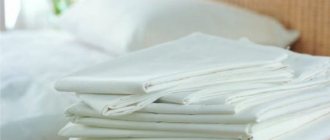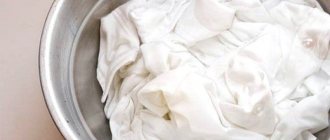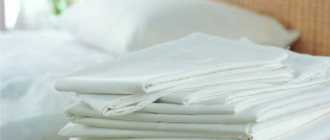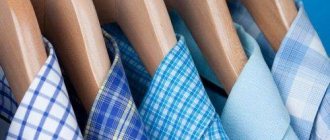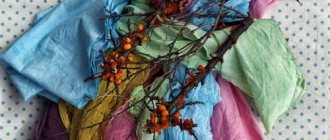All knitted products are essentially unique. After all, they were created by needlewomen with their own hands. These things can be inherited; they have unique intertwining patterns. Therefore, everyone wants such a thing to always be clean, have an impeccable appearance, and remind everyone of something special. Needlewomen will tell us how to properly starch such products.
Types of starching
Before touching on the issue of starching itself, you need to determine which products cannot be starched:
- Various types of synthetics;
- Products with dark threads, as white spots may appear on the latter;
- Underwear, because a starched product will not “breathe”.
Starching can be divided into several types - it all depends on the specific item and the desired result:
- Soft method. The substance is prepared at the rate of 1 tbsp. l. starch per 1 liter. boiling water This method is ideal for handkerchiefs and any other light fabrics - dresses, blouses, etc.;
- Medium density. The same as the previous one, but the ratio of starch to water is 1.5 tbsp. l. for 1 l. Suitable for all types of white linen, curtains, tulle, etc.;
- The hard way. In 1 l. boiling water dissolves a couple of tablespoons of starch. Then parts of the clothes are bleached separately - collars, cuffs, etc.
Preparation of products
Knitted items can be starched only if the following conditions are met:
- the item must be clean and washed;
- there are no stains or dirt on it.
Also, not all fabrics and fibers can be starched. The following materials cannot be processed:
- fabrics made from 100% synthetic or natural with the addition of synthetic threads;
- things made of black and other dark fibers, they subsequently show white stains;
- underwear that will lose its ability to conduct air.
Starched knitted napkins on the table
Depending on the degree of required rigidity of the product, there are three degrees of starch:
- soft - suitable for compacting and giving the required shape to knitted curtains, curtains, tops and dresses;
- medium - will thicken knitted napkins and a hat;
- hard - you will need to starch a knitted crown, angel, snowflake, basket, collars, cuffs, boots.
Products for starching things
To preserve the excellent appearance of the item for as long as possible, and also to keep it in shape and bleached as much as possible, you can use the following ingredients for starching.
Starch
Before use, we need to determine what severity of treatment we need. Next, prepare a solution of rice, potato or corn starch. In a container, mix the starch with a small amount of cold water, then take a second container, pour the solution into it and, stirring, pour in boiling water.
Good to know ! If you next need to add blue, the solution must first be filtered so that no lumps form in it. If a hard starch method is used, the solution can be boiled several times so that it becomes as cloudy as possible, and not completely transparent.
Then we send the item into the resulting mixture for a while, and then squeeze it out. If the item is completely white (for example, a scarf), then the starch can be mixed not with water, but with milk.
Sugar syrup
Pour 400 grams of sugar into water, stirring gradually. Place the solution on the fire and bring to a boil until the Sugar is completely dissolved. Then we put the item in the resulting solution, soak it as much as possible, and then wring it out.
If after the procedure part of the product is not completely starched, then it is worth repeating it. Or use an ordinary brush, as if “painting” a knitted item. If it is not possible to achieve the required rigidity, the process is repeated.
Having wrung out the item, straighten it out, pin it to a clean fabric with pins, then lay it out on a horizontal, flat surface, and send it to dry in a warm, well-ventilated place.
PVA glue
To obtain a solution, mix glue and hot water in a ratio of 1 to 1 or 1 to 2. Then the mixture is poured into a liquid sprayer, and the product is thoroughly sprayed. You can also pour liquid into a bucket and send the thing into it.
Milk
In most cases, it is used for starching products made from light fabrics. But, it is important to take only skim milk. You can also add starch itself to achieve a thicker consistency.
Gelatin
1 tbsp. l. gelatin is diluted with 200 ml. cold water and leave until it swells. Afterwards, another 200 ml is added to the container with the substance. boiling water, set aside until completely dissolved.
You can also take a whole bag of gelatin and add 1 tbsp to a glass. l. table salt, and pour the solution into a 0.5 jar of hot water. Then wait until the mixture is completely dissolved.
In both the first and second versions, the product is immersed in a completely cooled solution. An item starched in this way will keep its shape perfectly until the next wash.
Glossy starch
You can buy it ready-made, or prepare it yourself. In addition to hardness, this substance can give any thing a glossy shine. Therefore, it is useful for the most elegant things, as well as tulle with curtains.
Recipe . The substance consists of wheat or rice starch, white talc, and borax powder. The proportions are 5 to 3 to 1. You can take rice starch, borax, boric acid in a ratio of 8 to 10 to 2.
Each of the substances is thoroughly mixed, then diluted into a paste using cold water, and applied to the product using a sponge. After ironing the item, it becomes shiny and durable.
What you can’t starch
In addition to many positive qualities - stability of shape, less susceptibility to contamination, straightening of the curled edge, straightening of the pattern, starched items also acquire some properties with a dual effect. Thus, a film is formed on the surface of starched products, which, in fact, provides all the good qualities listed above. But the fact is that it does not allow air to pass through.
That is why it is not recommended to starch knitted items that were originally intended to be “breathable”.
Also, you should not treat things knitted with black threads with starch solution, as this will result in unsightly white stains.
And it is completely useless to starch products made from synthetic threads. Simply because yarn of this composition will not accept starch.
How to starch a knitted napkin
First, you need to determine the material from which the napkin is knitted. The most commonly used are cotton, pekhorka and viscose. And for all materials the methods are different.
Secondly, if the threads of the napkin are thick, then it should be kept in the substance for 15 minutes. If average - no more than 10. Very thin - 5 minutes.
Let's take the simplest recipe - water and starch (any). Now let's use the recipe:
- 1 tbsp. l. Pour starch into a container of the required size;
- Add a little cold clean water to mix the substance until smooth;
- Pour a liter of boiling water;
- Put on fire, boil for 5-10 minutes until we get a homogeneous mass without lumps, cloudy in color;
- We lower our product into the container and wait;
- We take out a napkin, place it on a flat surface, and wait for it to dry completely.
This recipe is universal and can be used for all types of starch and knitted items.
Another recipe:
- 3 tbsp. l. dissolve sugar in 200 ml. boiling water;
- Add starch to 1 liter. water, stir;
- Combine everything, mix again;
- We lower the product into the container.
Dry method of starching napkins
Also quite uncomplicated and simple method:
- We place our napkin on clean paper;
- Sprinkle the product a little with starch;
- Spray with water (evenly);
- Cover with another sheet of paper and wait 2 hours;
- Ready!
Good to know ! When drying such a napkin, you should take a large white Whatman paper. It is better not to use newspapers and other types of paper.
Small tricks
With the help of recommendations, you can easily correct an unsuccessful area or give shape to non-standard things.
- If during the process of drying a starched item it turns out that the shape needs to be corrected, the defective area is heated over steam, then fixed in the desired position and dried.
- To give a knitted hat the desired shape, it is put on an object that is most suitable in shape and size, for example, a ball or a can. If there are brims, then a hole is cut in the cardboard box to the size of the item on which the hat is dried, and the brims are laid out throughout the box.
- To dry a knitted vase with a narrow neck and at the same time maintain its shape, dry beans are poured inside. Once the vase is dry, the beans can be easily poured out.
- To preserve the shape of the openwork napkin, before starching, lay it out on a sheet of paper and trace along the contour of the pattern with a pencil. After processing, the napkin is combined with the pattern and secured with pins.
Having no experience in starching knitted items, it is advisable to first try your hand at something not very valuable. This way you can not only fill your hand, but also clarify the proportions, which greatly depend on the composition and quality of the material, as well as the characteristics of the ingredients used.
Note to the needlewoman
If you decide to starch your favorite knitted (and other) items, then these useful tips will be in your favor:
- If liquid gets on a product that has been starched, the procedure will have to be done again;
- You need to dry things carefully. If you iron them wet, all the snow-white parts may turn yellowish;
- You should not send freshly starched items to damp places for storage - they can “acquire” mold, which will simply destroy the item;
- If the mixture is not very clean, but has turned gray or yellowed, then before work it must be thoroughly mixed until the dirty layer disappears;
- When using sugar syrup for starching, remember that such a thing can become an “object” of attention of various insects;
- In order for the product to “stand” after starching, you need to prepare the thickest possible solution, then stretch the product onto a strong frame and dry it in the sun or in a warm place;
- If any elements stick together on the product after starching, you can simply hold them over a boiling kettle for a couple of minutes, and then “comb” them with a comb;
- To prevent starched items from sticking to the iron during ironing, starch should be made with milk rather than boiled water;
- To speed up the process as much as possible, the product soaked in the solution should be placed in the microwave for a couple of minutes, setting the maximum power, then squeezed out, and sent to dry. Starching with this method is carried out more efficiently.
A few words about drying
It is worth considering one important point - starched items should not be exposed to frost, since at low temperatures the starch can turn into sugar and become sticky.
All starched items must be placed on a dry, clean white cloth and sent to a well-ventilated area, waiting until completely dry. You can also use a regular towel - pin the product to it with pins.
Starchy, damp items can also be ironed by placing a clean, thin cloth on the item and setting the temperature to the minimum setting. But this must be done extremely carefully.
Follow these simple instructions and recommendations, and all your knitted items will be elegant and very beautiful.
How do you like the article?
Drying and storage rules
How to starch a knitted item is now clear, but this is only half of the good result. In order to avoid yellowing later on light-colored objects, it is necessary to dry things thoroughly. This is done at room temperature, away from all kinds of heating devices. The products are laid out on towels or stretched onto glass and plastic forms (jars, salad bowls, bottles) and secured with pins if necessary.
Before ironing, items must be perfectly dry. Ironing damp, starched fabric will cause yellow stains.
After starching things, they should be stored in dry rooms. High humidity can favor the formation of mold and fungal growth on the surface of the fabric. Things starched with sugar can attract the attention of insects. This nuance should be taken into account when choosing substances for compaction.
The process of starching knitted items is not difficult, but the result will exceed all expectations. The result of the work will be elegant products with impeccable shape.
Another interesting article: How to wash a hockey uniform.
Starch concentration in solution
The starching process involves immersing clothing or linen in an aqueous solution of starch, most often potato starch. The starch content of this mixture depends on the type of fabric to be treated. The denser the fabric, the higher the starch concentration should be.
Mild starching method (low starch concentration)
This treatment gives things elasticity without making them rigid. Thin fabrics are starched in this way: silk, cambric, chiffon. To prepare a suitable composition you need:
- thoroughly dissolve 1 teaspoon of starch in a glass of cold water;
- pour the resulting solution into 800 ml of boiling water;
- bring the composition to a paste state;
- cool the made starch.
Since things processed in this way should not be wrung out too much and should not be over-dried, many people use this type of starch in the form of a spray, pouring it into a spray bottle.
Semi-hard method (medium concentration)
This method is used for starching bed linen, aprons, men's shirts, and table textiles. After this, things take on a stable form.


